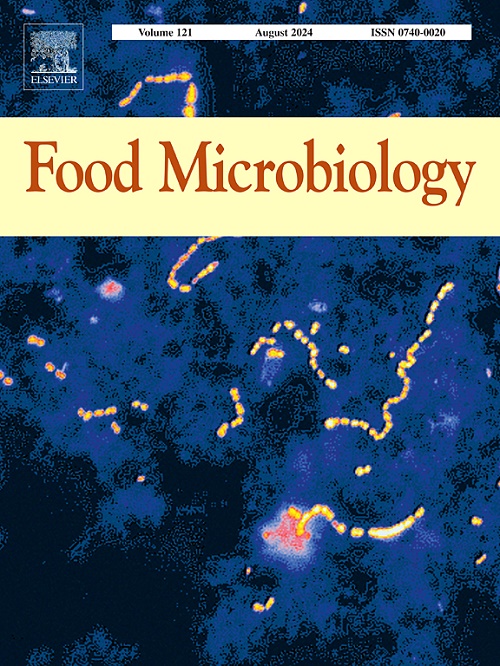过量产生核黄素的长双歧杆菌亚种的特性。玫瑰黄素处理婴儿菌株筛选
IF 4.6
1区 农林科学
Q1 BIOTECHNOLOGY & APPLIED MICROBIOLOGY
引用次数: 0
摘要
饮食是人类核黄素(B2)的主要来源。它也可以由与食物一起摄入的乳酸菌和肠道微生物共生菌产生,包括一些双歧杆菌。本文对影响长双歧杆菌亚种ribD转录和翻译的潜在调控机制进行了计算机分析。提出了婴儿。用长叶玫瑰黄素处理核黄素过量菌株。婴儿CECT4551T及其自发衍生物IPLA60011。对两个亲本菌株进行全基因组测序,并对产生核黄素过量菌株的肋簇进行测序。检测到影响fmn -核糖开关适体区不同茎环参与肋骨表达调控的准时突变。在RAMc和MRSc培养中,衍生菌株的核黄素过量产生在64.9 ~ 441.2 μg/L之间。这些水平与肋骨FMN核糖开关适配体区域和/或表达平台的预测二次折叠和稳定性相关。暴露于玫瑰黄素后,过量生产核黄素衍生物的安全性和技术特性(就抗生素耐药性和碳水化合物利用能力而言)没有发生改变,从而证实了过量生产核黄素衍生物生产生物强化食品(如以乳制品为基质配制的食品)的潜在能力。本文章由计算机程序翻译,如有差异,请以英文原文为准。

Characterization of riboflavin-overproducing Bifidobacterium longum subsp. infantis strains selected by roseoflavin treatment
Diet is the primary source of riboflavin (B2) for humans. It can also be produced by lactic acid bacteria ingested with foods and by gut microbial commensals, including some bifidobacteria. Herein an in silico analysis of potential regulatory mechanisms affecting ribD transcription and translation in Bifidobacterium longum subsp. infantis is presented. Riboflavin-overproducing strains were selected by treatment with roseoflavin of B. longum susbp. infantis CECT4551T and its spontaneous derivative IPLA60011. Whole genomes of both parental strains and the sequencing of the rib clusters of the riboflavin-overproducing ones were conducted. Punctual mutations affecting different stem-loops in the aptamer region of the FMN-riboswitch involved in the regulation of the rib expression were detected. Riboflavin overproduction of the derivative strains was confirmed through HPLC quantification in RAMc and MRSc cultures, ranging from 64.9 to 441.2 μg/L. These levels correlated to predicted secondary folding and stability of the aptamer region and/or expression platform of the rib FMN riboswitch. Safety and technological properties of the riboflavin-overproducing derivatives, in terms of antibiotic resistance profile and carbohydrate utilization capabilities, were not altered following roseoflavin exposure, thus confirming the potential aptitude of the riboflavin-overproducing derivatives to produce biofortified foods such as those formulated on dairy matrixes.
求助全文
通过发布文献求助,成功后即可免费获取论文全文。
去求助
来源期刊

Food microbiology
工程技术-生物工程与应用微生物
CiteScore
11.30
自引率
3.80%
发文量
179
审稿时长
44 days
期刊介绍:
Food Microbiology publishes original research articles, short communications, review papers, letters, news items and book reviews dealing with all aspects of the microbiology of foods. The editors aim to publish manuscripts of the highest quality which are both relevant and applicable to the broad field covered by the journal. Studies must be novel, have a clear connection to food microbiology, and be of general interest to the international community of food microbiologists. The editors make every effort to ensure rapid and fair reviews, resulting in timely publication of accepted manuscripts.
 求助内容:
求助内容: 应助结果提醒方式:
应助结果提醒方式:


